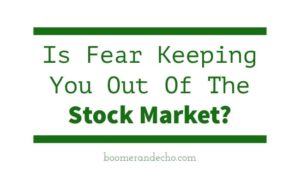 The biggest concern for many investors is the fear of losing their money. The stock markets have shown some volatility the last few weeks, and the recent screaming headlines in the financial media do nothing but encourage panic.
The biggest concern for many investors is the fear of losing their money. The stock markets have shown some volatility the last few weeks, and the recent screaming headlines in the financial media do nothing but encourage panic.
Some people think the latest bull market has overvalued stocks and a major market meltdown is imminent. They are sitting on their cash and waiting for the right entry point.
According to a BlackRock survey, 70% of adults aged 25 to 36 are also clinging to cash assets. Apparently, these Millennials don’t have much trust in the stock market and are afraid of another large market crash. This puts them at risk of not having enough saved to enjoy a comfortable retirement.
It’s true. Investing in equities does carry risks. Market corrections (drop of about 10%) are common. Bear markets (drop of 20% or more) will likely occur during an investor’s lifetime.
Even a reasonably diversified portfolio of stocks lost about half of its value during the 2008-2009 market crash. However, avoiding equities completely isn’t the best strategy. The stock market can be good to investors who have the discipline.
What can you do to get over your stock market fears?
1.) Educate yourself
Combat your fears with knowledge. Learn the basics: how the markets work so you can prepare yourself for future market conditions. The more you know, the less afraid you become, but avoid information overload.
Stop reading the gloom and doom reports in the financial media. Your financial education should not come from the news media. They need something to report and tend to sensationalize short-term market events to grab our attention. Just because something appears in print doesn’t guarantee that the information is correct. Look for reliable sources.
Investing magazines and books can provide useful information.
Knowledge is freely available on the Internet. Basic investing information is available at sites like Get Smarter About Money and Canadian Securities Administrators. Some social media sites, forums and financial blogs are worthwhile if written by knowledgeable authors.
Lack of confidence and second guessing yourself can paralyze your decision making. If you’re afraid of picking the wrong investments, turn to a professional for help. You could also try one of the many well-publicized model portfolios that have yielded good returns.
2.) Take a long-term investing approach
The biggest fear of investing is losing a lot of money in a short period of time.
Investing is a long-term process and is most likely your only way to reach your long-term financial goals.
Consider the benefit of investing sooner rather than later. Time is on your side.
Don’t keep monitoring your portfolio. This is psychologically hard, but don’t let short-term losses bother you too much. No one likes losing money, but it will be temporary. You’re not going to need this money to survive tomorrow, or next month, will you?
Acknowledge short-term market risks, but trust in long-term historical gains and commit to long-term investments.
Even if you are in, or close to, retirement you probably still have a long horizon of a decade or more. You still need to invest a portion of your portfolio in the stock market to get better long-term performance and beat the effects of ongoing inflation to keep your purchasing power.
3.) Determine how much risk you need to take to reach your financial goals
You can’t control stock market performance, but you can control how much risk you are willing to take.
Just because everyone you know is gung-ho about how much money they’ve made in the stock market doesn’t mean you have to jump on the wagon and take on a lot of risk if you don’t need to. You may be able to reach your goals with more modest returns in a portfolio of mostly GICs and other fixed income, with a smaller portion in equities for growth.
If you determine you’ll need a larger return of 5% or more and you’re still not comfortable accepting the risk that comes with it, the only solution is either to save a lot more or scale back your goals. It’s not worth losing sleep over it.
4.) Be cautious about investments targeted to the risk-averse
Market volatility always increases interest in investment products that come with a principal guarantee. These investments include market-linked GICs and Principal Protected Notes (PPNs). They promise the chance to capture the upside of a rising stock market without the risk of losing your principal if the market drops instead.
Don’t get caught up in a compelling sales pitch. These products are complicated and guarantees come with a steep cost.
Final thoughts
The future is always uncertain. But, if you wait on the sidelines hoping for the “right time” you’ll never get your investing started. Making the leap into the stock market can be scary. But, “It’s scary” is not a good excuse.
If you want to be a successful investor and reach your goals, let go of events you can’t control and devote your time and energy to the things you can. How much you save and invest each year will have a greater impact on your retirement lifestyle than anything reported in today’s news.
Making regular investments in a diversified portfolio is always the thing to do.
Over time, the benefits will be obvious.
 Marie Engen is the “Boomer” half of Boomer & Echo. In addition to being co-author of the website, Marie is a fee-only financial planner based in Kelowna, B.C. This article originally ran at the Boomer & Echo site on Feb. 20, 2018 and is republished here with permission
Marie Engen is the “Boomer” half of Boomer & Echo. In addition to being co-author of the website, Marie is a fee-only financial planner based in Kelowna, B.C. This article originally ran at the Boomer & Echo site on Feb. 20, 2018 and is republished here with permission

